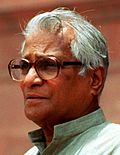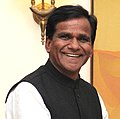Top Qs
Timeline
Chat
Perspective
Ministry of Railways (India)
Government ministry of India From Wikipedia, the free encyclopedia
Remove ads
The Ministry of Railways is a ministry in the Government of India, responsible for the country's rail transport. The Indian Railways is the rail network operated and administered by the Railway Board constituted by the ministry. The ministry along with the Railway Board is housed inside Rail Bhawan in New Delhi. It is headed by the Minister of Railways. With more than 1.2 million employees, it is one of the world's largest employers.
Remove ads
Remove ads
History
Summarize
Perspective
The first railway track was operational in Madras in 1837 and the first passenger train ran in Bombay in 1853.[4][5] But the earlier railways were operated by private companies with the earliest being the Madras Railway established in 1845 and the Great Indian Peninsular Railway incorporated in 1849.[6] In October 1901, the Secretary of State for India in Council appointed Thomas Robertson as a special commissioner for Indian Railways to prepare a report on the administration of Indian Railways.[7] In his report in 1903, Thomas recommended setting up of a three-member Railway Board headed by a chief commissioner.[7] In March 1905, the railway branch of the Public Works Department was transferred to the newly established railway board under the department of commerce and industry by the Indian Railway Board Act.[8] In 1908, the set up was re-organized on the recommendations of the Railway Finance Committee (1908) by constituting the railway board headed by a president as a separate department.[7] Pursuant to the Acworth committee's recommendations in 1921, the railway board was expanded to four members with the addition of a financial commissioner in 1924 apart from the chief commissioner, one commissioners responsible for ways and works, projects and stores and the other responsible for general administration, staff and traffic.[7]
In 1929, an additional member was added to the board and was assigned the responsibility for staff, so that the member in charge of traffic could focus solely on transport and commercial matters.[9] In 1944, all the railway companies were taken over by the Government.[10] The ministry of railways was part of the Ministry of Transport after the independence in 1947 and John Mathai served as its first minister from 1947 till 1948.[11][12] On 22 September 1948, N. Gopalaswamy Ayyangar was appointed as the minister of the newly renamed Ministry of Railways and Transport.[13] On 17 April 1957, Jagjivan Ram became the first to head the standalone Minister of Railways.[14]
In December 1950, the Central Advisory Committee for Railways approved the plan for re-organising Indian Railways into six regional zones and re-constituting the railway board to four members with the senior-most functional member appointed the chairman of the board with no absolute over riding power.[15][16] In October 1954, the chairman of the board was made responsible for decisions on technical and policy matters, with the status of a principal secretary to the Government of India with an additional member added.[16]
The board was expanded with an additional member responsible for electrical engineering in 1972 and a further member responsible for health in 1976.[17]
The Ministry of Railways was merged with the Ministry of Shipping and Transport and the Department of Civil Aviation on 25 September 1985 to form the Ministry of Transport and Bansi Lal, who served as the Railways Minister prior to the merger became the first holder of the new office.[18] However, on 22 October 1986, the Ministry of Railways was again separated into an independent ministry and has been the same since then.[14][19]
In 2004, the board is expanded by the introduction of two new members responsible for signalling & telecom and for stores respectively.[20] In December 2019, the Union Cabinet decided to reduce the size of the board from eight to five.[21]
Railway Budget
The first railway budget was presented in 1924.[6] Since then, Railway budget was presented as a standalone budget every year before the union budget by the Railway Minister till 2016.[22] The last Railway Budget was presented on 25 February 2016 and on 21 September 2016, Government of India approved merger of the rail and general budgets from 2017.[23] The railway budget was estimated to be ₹264,600 crore (US$31 billion) for the financial year 2023–24.[24]
Remove ads
Organisation
Summarize
Perspective
The ministry has a union minister and one or more ministers of state.[25] The railway board reports to the union ministry with the directorates of traction, engineering, traffic, rolling stock, signalling, materials, personnel, Railway Protection Force (RPF), finance, health and safety reporting to the board.[26] Indian Railways is a statutory body that reports to parliament and is under the ownership of ministry of railways.[27] Indian Railways is further divided into 18 administrative zones (17 operational), headed by general managers who report to the board along with the heads of other institutions and undertakings owned by the Indian Railways.[26] The railway board consists of a chairman, four members responsible for operations, business development, human resources, infrastructure and finance respectively.[28] Also part of the board are four director generals responsible for human resources, health, RPF and safety respectively.[28]
Statutory Bodies
- Rail India Technical and Economic Service
- Rail Land Development Authority
- IRCON International
- Rail Vikas Nigam Limited
- Indian Railways Finance Corporation
- Centre for Railway Information Systems
Remove ads
Railway Budget
The first railway budget was presented in 1924.[6] Since then, Railway budget was presented as a standalone budget every year before the union budget till 2016.[29] The last Railway Budget was presented on 25 February 2016 and on 21 September 2016, Government of India approved merger of the rail and general budgets from 2017.[30] The railway budget is estimated to be ₹264,600 crore (US$31 billion) for the financial year 2023–24.[31]
Railway ministers
Summarize
Perspective
The Minister of Railways (Hindi:Rail Mantrī) is the head of the ministry and a member of the union council of ministers of India. The position of the Minister of Railways is usually held by a minister of cabinet rank and is often assisted by one or two junior Ministers of State.[32]
John Mathai was the first Minister of Railways.[12] Lal Bahadur Shastri who served as the Minister of Railways and Transport from 1952 until 1956 became the second Prime Minister of India in 1964.[33] Four prime ministers, namely Rajiv Gandhi, P. V. Narasimha Rao, Atal Bihari Vajpayee (twice) and Manmohan Singh (twice) have briefly held the portfolio of the Minister of Railways during their premiership.[14] Mohsina Kidwai was the first female to hold the charge of the ministry (as Minister of Surface Transport) while Mamata Banerjee is the first female to have served as the Minister of Railways.[14] Madhavrao Scindia and Ram Naik are the only people to have served as Ministers of State for Railways with an Independent charge. Lalit Narayan Mishra is the only cabinet minister to die in office after being assassinated in a bomb blast in 1975,[34] while Suresh Angadi is the only minister of state to die in office.[35]
C k Jaffer sheriff was the Railway minister from 1991 to 1995 made numerous progress in laying More railway lines he is from Indian national Congress karnataka
The current Minister of Railways is Ashwini Vaishnaw of the Bharatiya Janata Party who has been in office since 7 July 2021 while V. Somanna and Ravneet Singh are the ministers of state for railways.[36]
Cabinet Ministers
- Key: † Assassinated or died in office
- Note: MoS, I/C – Minister of State (Independent Charge)
Ministers of State
- Key: † Assassinated or died in office
Deputy Ministers
Remove ads
Criticism and controversies
On 14 February 2008, Westinghouse Air Brake, admitted to a US federal court of violating Foreign Corrupt Practices Act (FCPA) regulations by making improper payments from its subsidiary Pioneer Friction based in Kolkata, to government officials of the Indian railway board to obtain and retain business with the Railway Board and curb taxes.[41]
On 3 May 2013, the CBI arrested then minister of railways Pawan Kumar Bansal's nephew, Vijay Singla for accepting an alleged bribe of ₹9 million (US$110,000) from a middleman for the appointment of a particular person to the railway board.[42] The railway board clarified that no rules had been broken during the appointment and suspended Mahesh, the person concerned.[43]
Remove ads
References
External links
Wikiwand - on
Seamless Wikipedia browsing. On steroids.
Remove ads













































































